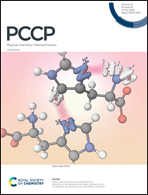Structures and chemical bonding of boron-based B12O and B11Au clusters. A counterexample in boronyl chemistry†
Abstract
Boron oxide clusters have structural diversity and unique chemical bonding, and recent literature has shown that boronyl complexes dominate boron-rich oxide clusters. A counterexample in boronyl chemistry is presented in this work. Using global structural searches, electronic structure calculations, and chemical bonding analyses, we shall report on the computational design of two boron-based quasi-planar or planar clusters: B12O and B11Au. Contrary to expectation, the B12O cluster has a circular quasi-planar shape with a peripheral B–O–B bridge, which resembles bare B12 cluster. It does not contain a boronyl ligand. The isomeric boronyl complex turns out to be 10.32 kcal mol−1 higher in energy at the single-point CCSD(T) level. In contrast, B11Au cluster behaves normally with an elongated B11 moiety and a terminal Au ligand. Chemical bonding analyses reveal three-fold π/σ aromaticity in circular B12O cluster, including global 6π aromaticity, as well as spatially isolated inner 2σ aromaticity and outer 10σ aromaticity. The three-fold 6π/2σ/10σ aromaticity underlies the stability of B12O cluster. This bonding picture is unknown for bare B12 cluster and its derivatives. The elongated B11Au cluster has conflicting π/σ aromaticity (with 6π versus 8σ electron-counting). The B12O cluster is actually isoelectronic with bare B12 cluster in terms of delocalized π/σ bonding, which inherits the structural and electronic robustness of the latter.



 Please wait while we load your content...
Please wait while we load your content...